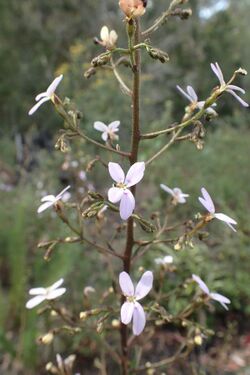Biology:Stylidium laricifolium
| Stylidium laricifolium | |
|---|---|

| |
| In the Gibraltar Range National Park | |
| Scientific classification | |
| Kingdom: | Plantae |
| Clade: | Tracheophytes |
| Clade: | Angiosperms |
| Clade: | Eudicots |
| Clade: | Asterids |
| Order: | Asterales |
| Family: | Stylidiaceae |
| Genus: | Stylidium |
| Subgenus: | Stylidium subg. Tolypangium |
| Section: | Stylidium sect. Sparsifoliae |
| Species: | S. laricifolium
|
| Binomial name | |
| Stylidium laricifolium | |
| Synonyms[1] | |
| |
Stylidium laricifolium, commonly known as giant trigger-plant, [2] larch-leaf or tree triggerplant,[3] or is a species of flowering plant in the family Stylidiaceae and is endemic to eastern Australia. It is a perennial subshrub with many linear leaves crowded along its few stems, the flowers white to pale pink and arranged in a single main panicle and smaller racemes.
Description
Stylidium laricifolium is a perennial subshrub with few stems, that typically grows to a height of 0.3–1.5 m (1 ft 0 in–4 ft 11 in). The leaves are linear, 10–80 mm (0.39–3.15 in) long, about 1–2 mm (0.039–0.079 in) wide and crowded along the stems. The flowering stems are 14–45 cm (5.5–17.7 in) high, with between ten and thirty flowers arranged in a single main panicle and several smaller racemes. The sepals are narrow lance-shaped, 1.5–2 mm (0.059–0.079 in) long and joined at the base forming a tube longer than the lobes. The corolla is white to pale pink, about 10–15 mm (0.39–0.59 in) wide with two pairs of oblong petals. The column is 6–7 mm (0.24–0.28 in) long with a cushion-like stigma and the ovary is 3–4 mm (0.12–0.16 in) long and covered with glandular hairs. Flowering occurs from September to December and the fruit is an oblong capsule 8–12 mm (0.31–0.47 in) long.[2][4]
Taxonomy
Stylidium laricifolium was first formally described in 1806 by Louis Claude Richard in Christiaan Hendrik Persoon's book Synopsis plantarum.[5][6] The specific epithet laricifolium refers to the long, narrow leaves, which resemble the leaf form of plants in the Larix genus.[3] The type specimen was probably collected during Nicholas Baudin's expedition to Australia, which included a visit to Port Jackson in 1802.[7]
Distribution and habitat
Giant trigger-plant grows in forest in rocky places from south-east Queensland, along the coast and tablelands of New South Wales to eastern Victoria.[2][4]
See also
References
- ↑ 1.0 1.1 "Stylidium laricifolium". Australian Plant Census. https://biodiversity.org.au/nsl/services/apc-format/display/60056.
- ↑ 2.0 2.1 2.2 Stanberg, Leonie. "Stylidium laricifolium". Royal Botanic Garden Sydney. https://plantnet.rbgsyd.nsw.gov.au/cgi-bin/NSWfl.pl?page=nswfl&lvl=sp&name=Stylidium~laricifolium.
- ↑ 3.0 3.1 Darnowski, Douglas W. (2002). Triggerplants. Australia: Rosenberg Publishing
- ↑ 4.0 4.1 Ohlsen, Daniel. "Stylidium laricifolium". Royal Botanic Gardens Victoria. https://vicflora.rbg.vic.gov.au/flora/taxon/a201fa12-681f-4ab4-a216-248c23823491.
- ↑ "Stylidium laricifolium". APNI. https://id.biodiversity.org.au/instance/apni/464841.
- ↑ Richard, Louis C. (1806). Christiaan H. Persoon. ed. Synopsis plantarum, seu enchiridium botanicum, complectens enumerationem systematicam specierum. 2. p. 210. https://www.biodiversitylibrary.org/item/11127#page/213/mode/1up. Retrieved 21 September 2021.
- ↑ Wege, J.A. (2017). "Stylidium miscellany 3: a synopsis of Robert Brown’s Stylidiaceae types and occasional notes on associated names". Nuytsia 28: 240. https://florabase.dpaw.wa.gov.au/science/nuytsia/810.pdf. Retrieved 21 September 2021.
Wikidata ☰ Q7629561 entry
 |




